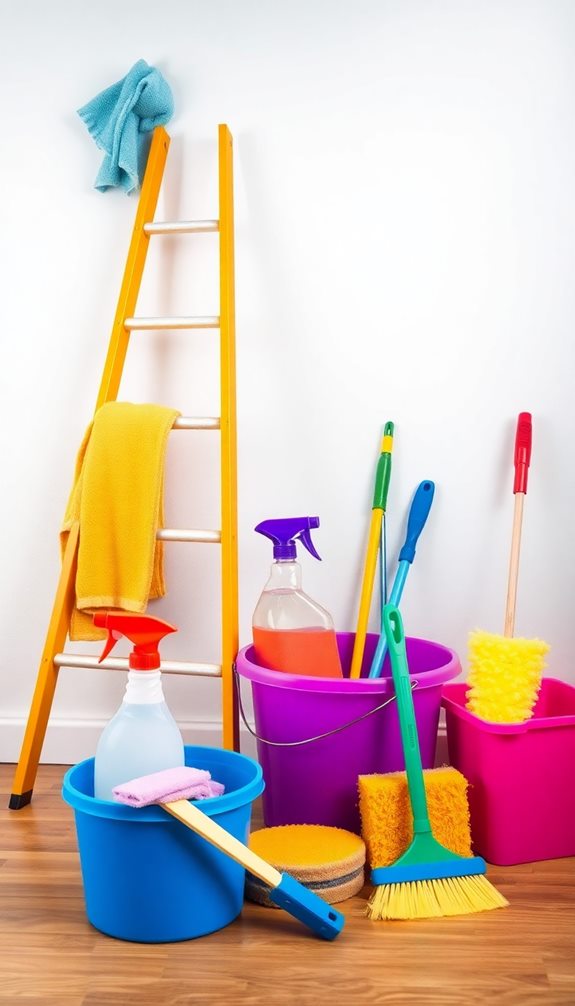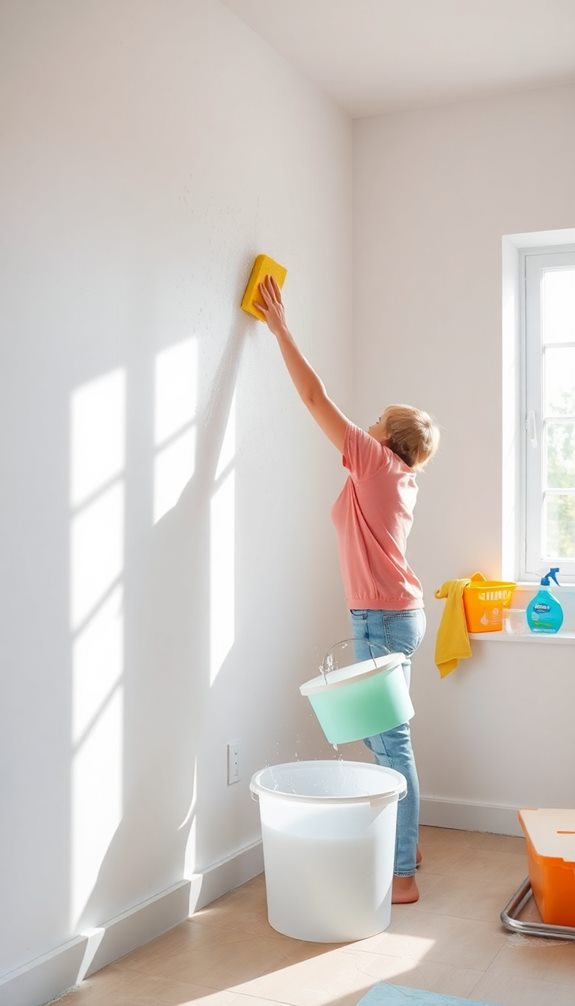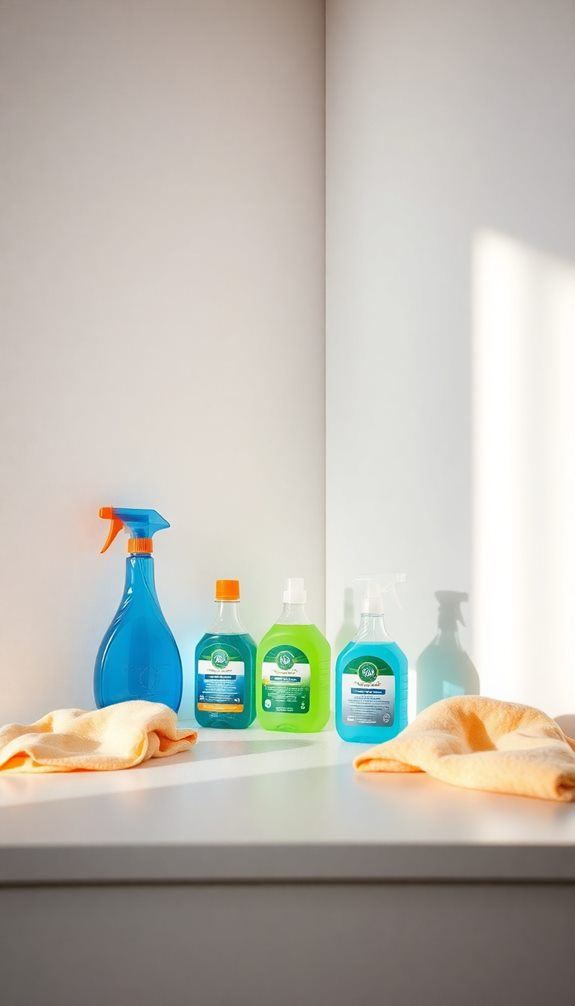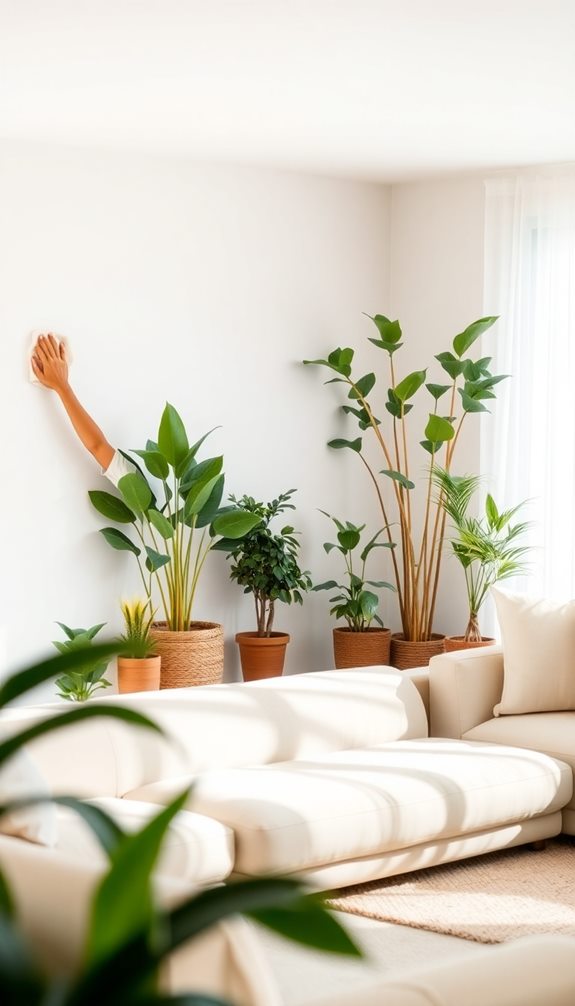You can easily maintain a stain-free home with DIY wall washing solutions that use natural ingredients. Mix vinegar, baking soda, and warm water to create effective cleaning solutions. Use microfiber cloths for streak-free cleaning and spot treat stubborn stains with a paste of baking soda and water. Schedule wall cleaning every 6-8 weeks to prevent dirt build-up, and use a gentle approach to avoid damaging surfaces. Always dust before washing to maximize effectiveness. With the right techniques and tools, keeping your walls clean becomes a breeze, and there's plenty more helpful information to enhance your wall care routine.
Importance of Wall Cleaning
Cleaning your walls regularly isn't just about keeping them looking good; it's essential for your health and home. Over time, dirt and grime can build up on your walls, negatively impacting indoor air quality and potentially triggering allergies or asthma symptoms. By incorporating wall cleaning into your routine maintenance, you're not only enhancing the aesthetics of your space but also creating a healthier environment.
Using non-toxic cleaning solutions can further protect your family's health while effectively removing buildup.
When you neglect wall maintenance, you risk long-term damage, like discoloration or the growth of mold and mildew, which can be costly to repair. Regular cleaning, ideally every 6-8 weeks for lighter colors, helps maintain your walls' appearance and prolongs the lifespan of your paint finishes.
Clean walls look fresher and more inviting, especially in high-traffic areas where dirt accumulates quickly.
Additionally, keeping your walls clean makes future repainting easier, as it prevents the buildup of grime that can hinder adhesion. So, make wall cleaning a part of your home care routine. You'll appreciate the improved hygiene, aesthetics, and the peace of mind that comes with knowing your space is well-maintained.
DIY Natural Cleaning Solutions
Maintaining clean walls is simple when you use DIY natural cleaning solutions. These solutions are made from common household ingredients like white vinegar, baking soda, and liquid dish soap, making them safe for your painted surfaces. In fact, using eco-friendly cleaning agents helps reduce health risks associated with harsh chemicals.
A great wall cleaning solution combines three pumps of liquid dish soap, two tablespoons of white vinegar, and four cups of hot water. You can use this mixture every 6-8 weeks to keep your walls looking fresh.
For stubborn stains, consider creating a paste using 1/4 cup of baking soda and water. This paste effectively lifts scuff marks and grime without damaging your walls. When you apply your cleaning solution, use a soft sponge to gently scrub the surface, ensuring you don't harm the paint.
If you want to enhance your DIY natural cleaning solutions, think about adding essential oils like tea tree or eucalyptus. These not only provide a pleasant scent but also add antibacterial properties to your wall cleaning routine.
With these simple cleaning tips, you'll have an all-purpose cleaner that helps you maintain clean painted walls effortlessly.
Essential Tools for Wall Cleaning

When it comes to wall cleaning, having the right tools makes all the difference.
You'll need must-have supplies like buckets, microfiber cloths, and spray bottles to streamline your process.
Gather cleaning gloves and sponges to enhance your effectiveness.
Plus, using effective techniques and keeping safety precautions in mind guarantees a successful and safe cleaning experience.
Must-Have Cleaning Supplies
To achieve spotless walls, having the right cleaning supplies at your fingertips makes all the difference.
Start with a microfiber cloth or a cellulose sponge; these are vital for applying your cleaning solutions and reducing streaks. A bucket is necessary for mixing your cleaning recipe, while a spray bottle can help you distribute stronger mixtures efficiently.
For most cleaning solutions, warm water is essential as it enhances the effectiveness of your efforts in removing dirt and grime. Consider adding liquid dish soap to your cleaning solution; it cuts through grease and stains effectively. If you want a more natural option, distilled white vinegar can be included for its antibacterial properties.
Optional tools like a squeegee microfiber mop and tack cloth can aid in dust removal and maintaining cleanliness in those hard-to-reach areas.
Remember to be gentle when cleaning, especially on delicate surfaces. With these must-have supplies in hand, you're well on your way to keeping your walls looking fresh and stain-free.
Equip yourself with these tools, and you'll make wall washing a breeze!
Effective Cleaning Techniques
Effective cleaning techniques can make a significant difference in how your walls look and feel. To maintain clean walls, gather some essential tools like microfiber cloths or cellulose sponges. These are perfect for gentle application and help prevent streaking while cleaning your walls.
For regular cleaning, use a bucket to mix your cleaning solution and a spray bottle for distributing stronger mixtures.
When tackling stains on your walls, consider spot cleaning with a clean rag. Dip it in a solution of water and wring it out to avoid excess moisture.
For larger wall surfaces, a squeegee microfiber mop can enhance your cleaning method, allowing for easy rinsing and effective dirt removal.
Don't forget to regularly vacuum or dust your walls using a soft brush attachment to eliminate loose dirt before you begin washing.
It's also essential to have a step stool or ladder handy for safely reaching high areas, ensuring every part of your wall gets the attention it deserves.
Safety Precautions Needed
Proper safety precautions are vital for a successful wall cleaning project. First, guarantee good ventilation by opening windows or using fans to minimize inhalation of fumes from cleaning solutions. This step is essential, especially when dealing with stronger cleaning agents.
Next, always wear gloves to protect your skin from potential irritation caused by these cleaning agents, such as vinegar or ammonia. Skin irritation can be uncomfortable, and gloves provide a barrier against harmful substances.
It's also important to avoid mixing different cleaning products. Combining solutions can lead to harmful chemical reactions, which could jeopardize your safety. Stick to one cleaning solution at a time for effective and safe results.
During your cleaning project, keep all cleaning solutions and tools out of reach of children. This precaution guarantees their safety while you focus on your task.
Finally, store all cleaning supplies properly after use to prevent spills and accidents. A well-organized space not only keeps you safe but also helps maintain a clean environment.
Steps for Regular Wall Maintenance
Regular wall maintenance is vital for keeping your home looking fresh and inviting. Schedule this task every 6-8 weeks, especially in high-traffic areas, to prevent dirt buildup.
Start by dusting walls with a vacuum or microfiber cloth to remove loose dirt and debris, greatly improving your cleaning effectiveness. You can also utilize green methods to clean and shine bath fixtures to maintain other areas of your home, guaranteeing a clean and eco-friendly environment.
Next, use a gentle method with warm water and a sponge to wipe down the walls. This approach won't damage your paint finishes while effectively removing surface dust. For tough stains, create a cleaning solution by mixing 1/4 cup of liquid dish soap with 1 gallon of warm water. For enhanced stain removal, add 1 cup of vinegar or ammonia.
Once you've tackled the stains, it's important to rinse walls with clean water. This step prevents any residue buildup from the cleaning solution.
Cleaning Techniques for Drywall

Cleaning drywall requires a careful approach to maintain its integrity. Start with a dry cleaning method by using a shop vacuum with a brush attachment to effectively remove dust and debris.
Once you've cleared the surface, it's time for wet cleaning. Use a nearly dry sponge and a mild cleaning solution to gently wipe down the walls. Remember, too much moisture can weaken the drywall, so keep it minimal.
For those who prefer eco-friendly options, consider using natural cleaning methods that are safe for your home environment.
Change the cleaning water frequently to avoid spreading dirt and grime back onto the surface. For tough stains, a baking soda paste can be your best friend. Mix 1/4 cup of baking soda with 1 tablespoon of water for effective stain removal.
Before applying any cleaning solution more broadly, always test it on a small, inconspicuous area of the drywall to verify it won't cause damage or discoloration.
Caring for Wallpapered Walls
Wallpapered walls can add a unique charm to your home, but they require special care to keep them looking their best. To clean your wallpaper, start by using a dry sponge for gentle dusting. This simple action helps prevent dirt buildup and maintains the wallpaper's appearance.
For vinyl wallpaper, mix warm water with mild dish soap to create an effective cleaning solution. You might also consider using natural solutions, such as vinegar, which can provide an eco-friendly option for cleaning surfaces. Explore expert cleaning tips for additional methods.
Use a damp cloth to wipe away dirt and stains, but remember to dry the surface immediately to prevent moisture absorption, which can lead to mold and mildew.
If you have older wallpaper, take a gentler approach. Test your cleaning solutions on a small, inconspicuous area first to verify there's no adverse effect on the material. Be cautious and avoid soaking the wallpaper, as excess moisture can damage it.
Regular maintenance is key; incorporate gentle dusting into your cleaning routine to extend the life of your wallpaper. By following these tips, you can keep your wallpapered walls looking fresh and inviting, ensuring that the unique charm they bring to your home stays vibrant for years to come.
Specialized Solutions for Stains

When stains mar your walls, addressing them swiftly can prevent further damage and keep your home looking its best. For tough stains, create a paste from 1/4 cup of baking soda and 1 tablespoon of water. This solution effectively lifts scuff marks and grime without harming the wall surface.
Additionally, using eco-friendly alternatives like vinegar and baking soda can enhance your cleaning routine. If you're dealing with general stains or odors, mix 3.5 cups of white vinegar with 1/2 gallon of water. This vinegar solution serves as a powerful natural cleaner.
For greasy kitchen walls, opt for a gentle degreaser, but be sure to follow the product instructions to avoid damaging your paint finish. Melamine sponges, often called Magic Erasers, can also remove scuff marks on glossy finishes. Just remember to test them on a hidden area first to guarantee they won't damage your paint.
For persistent stains, combine vinegar and baking soda with water, apply this mixture, and let it sit. Afterward, gently rub the area to clean and remove the stains. Rinse thoroughly to guarantee your walls look fresh and vibrant again.
With these specialized solutions, tackling wall stains becomes a straightforward task.
Safety Precautions During Cleaning
It's vital to prioritize safety while tackling any cleaning task. Start by confirming good ventilation; open windows or use fans to reduce inhalation of fumes from cleaning solutions, especially if you're working with vinegar or ammonia.
Additionally, consider using eco-friendly cleaning solutions to minimize exposure to harsh chemicals. This simple step can greatly improve air quality and minimize discomfort.
Next, always wear gloves to protect your skin from irritation and potential allergic reactions when handling cleaning agents. Your skin deserves protection from harsh chemicals.
Moreover, avoid mixing different cleaning products. This can lead to harmful chemical reactions that create toxic fumes, putting you at risk.
When you're working in your home, be mindful of children and pets. Store cleaning supplies, especially chemical solutions, out of their reach to prevent accidental exposure or ingestion.
It's imperative to keep your environment safe for everyone.
Lastly, make sure to store cleaning solutions in a cool, dry place and label them clearly. This prevents misuse and guarantees safety during your cleaning sessions.
Tips for Ongoing Wall Care

Keeping your walls looking fresh requires a proactive approach to ongoing care. Start by regularly dusting your walls with a microfiber cloth or a vacuum equipped with a brush attachment. This simple step helps prevent dirt and grime buildup and prepares your surfaces for deeper cleaning.
Just as with countertops, regular cleaning is essential to maintain a hygienic environment in your home. When you notice stains, don't wait—spot clean them immediately using a damp cloth with mild soapy water that's safe to use. This prevents stains from setting and becoming harder to remove later.
To keep your clean painted walls looking their best, schedule a thorough wall cleaning every 6-8 weeks, especially in high-traffic areas.
Choosing washable paint makes maintenance easier, allowing you to clean without worrying about damaging the finish. Additionally, inspect your walls periodically for signs of damage or wear. Addressing issues promptly can prolong the lifespan of your paint and maintain aesthetic appeal.
Conclusion
With your newfound knowledge of DIY wall washing solutions, you're ready to banish stains and keep your home looking fresh. Like a painter with a clean canvas, your walls will shine with renewed vibrancy. Remember, regular maintenance is key, so take a moment each month to touch up and care for your surfaces. Embrace these techniques, and soon enough, you'll find that a stain-free home isn't just a dream—it's your new reality.